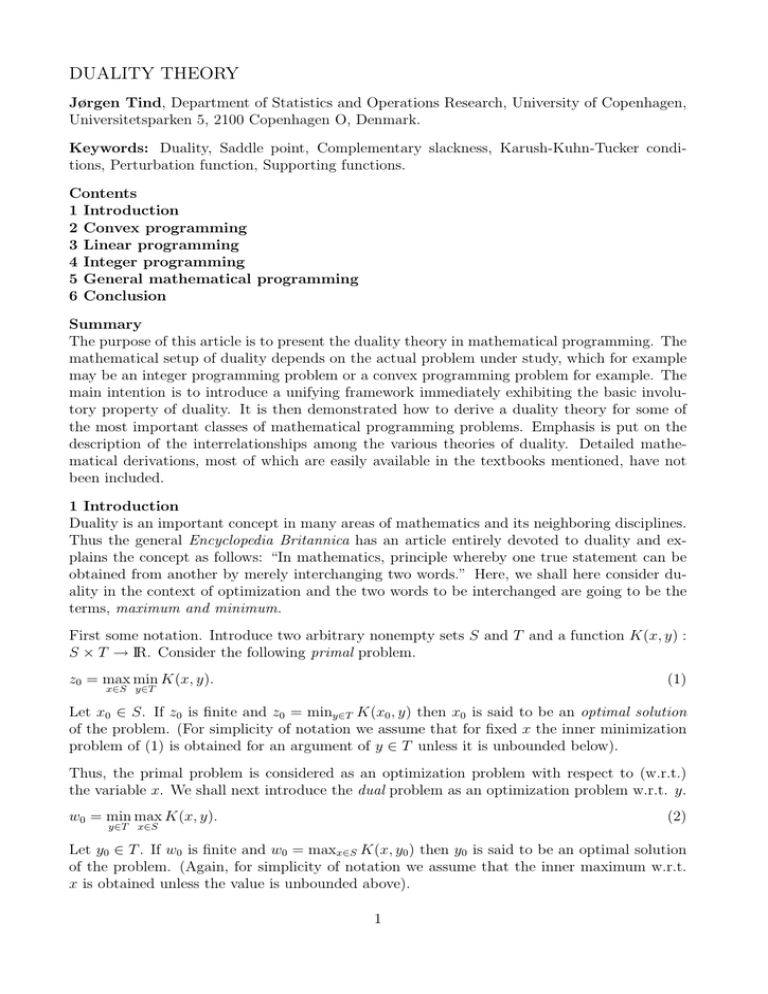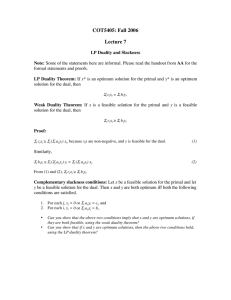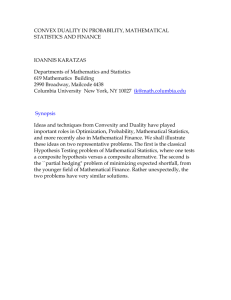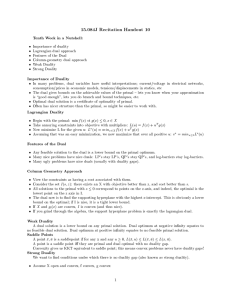DUALITY THEORY
advertisement

DUALITY THEORY
Jørgen Tind, Department of Statistics and Operations Research, University of Copenhagen,
Universitetsparken 5, 2100 Copenhagen O, Denmark.
Keywords: Duality, Saddle point, Complementary slackness, Karush-Kuhn-Tucker conditions, Perturbation function, Supporting functions.
Contents
1 Introduction
2 Convex programming
3 Linear programming
4 Integer programming
5 General mathematical programming
6 Conclusion
Summary
The purpose of this article is to present the duality theory in mathematical programming. The
mathematical setup of duality depends on the actual problem under study, which for example
may be an integer programming problem or a convex programming problem for example. The
main intention is to introduce a unifying framework immediately exhibiting the basic involutory property of duality. It is then demonstrated how to derive a duality theory for some of
the most important classes of mathematical programming problems. Emphasis is put on the
description of the interrelationships among the various theories of duality. Detailed mathematical derivations, most of which are easily available in the textbooks mentioned, have not
been included.
1 Introduction
Duality is an important concept in many areas of mathematics and its neighboring disciplines.
Thus the general Encyclopedia Britannica has an article entirely devoted to duality and explains the concept as follows: “In mathematics, principle whereby one true statement can be
obtained from another by merely interchanging two words.” Here, we shall here consider duality in the context of optimization and the two words to be interchanged are going to be the
terms, maximum and minimum.
First some notation. Introduce two arbitrary nonempty sets S and T and a function K(x, y) :
S × T → IR. Consider the following primal problem.
z0 = max min K(x, y).
(1)
x∈S y∈T
Let x0 ∈ S. If z0 is finite and z0 = miny∈T K(x0 , y) then x0 is said to be an optimal solution
of the problem. (For simplicity of notation we assume that for fixed x the inner minimization
problem of (1) is obtained for an argument of y ∈ T unless it is unbounded below).
Thus, the primal problem is considered as an optimization problem with respect to (w.r.t.)
the variable x. We shall next introduce the dual problem as an optimization problem w.r.t. y.
w0 = min max K(x, y).
(2)
y∈T x∈S
Let y0 ∈ T . If w0 is finite and w0 = maxx∈S K(x, y0 ) then y0 is said to be an optimal solution
of the problem. (Again, for simplicity of notation we assume that the inner maximum w.r.t.
x is obtained unless the value is unbounded above).
1
Note that the dual problem is equivalent to
− max min −K(x, y),
y∈T x∈S
which has the form of a primal problem. By the above definition its dual problem is
− min max −K(x, y),
x∈S y∈T
which is equivalent to (1). This exhibits the nice property of involution which says that the
dual of a dual problem is equal to the primal problem. We may thus speak of a pair of mutually
dual problems, in accordance with the above quotation from Encyclopedia Britannica.
The entire construction may be interpreted in the framework of a so-called zero-sum game
with two players, player 1 and player 2. Player 1 selects a strategy x among a possible set of
strategies S. Similarly, player 2 selects a strategy y ∈ T . According to the choice of strategies
an amount K(x, y), the so-called payoff, is transferred from player 2 to player 1. In the primal
problem (1) player 1 selects a (cautious) strategy for which this player is sure to receive at
least the amount z0 . Player 2 selects in the dual problem (2) a strategy such that w0 is a
guaranteed maximum amount to be paid to player 1.
It appears that the interesting cases are obtained when optimal solutions exist for both problems such that z0 = w0 . In this case we speak of strong duality. In general we have the
following so-called weak duality.
Proposition 1 z0 ≤ w0 .
Proof: For any x1 ∈ S we have K(x1 , y) ≤ maxx∈S K(x, y). Hence
min K(x1 , y) ≤ min max K(x, y).
y∈T
y∈T x∈S
Since x1 ∈ S is arbitrarily selected we get
max min K(x, y) ≤ min max K(x, y),
x∈S y∈T
y∈T x∈S
i.e. z0 ≤ w0 .
When strong duality does not exist, i.e. when z0 < w0 we speak of a duality gap between the
dual problems.
Closely related to strong duality is the following notion. (x0 , y0 ) ∈ S × T is a saddle point
provided that
K(x, y0 ) ≤ K(x0 , y0 ) ≤ K(x0 , y) for all (x, y) ∈ S × T.
The next proposition states the relationship.
Proposition 2 (x0 , y0 ) ∈ S × T is a saddle point if and only if i) x0 is an optimal solution of
the primal problem, ii) y0 is an optimal solution of the dual problem and iii) z0 = w0 .
2
Proof: By a reformulation of the definition we get that (x0 , y0 ) is a saddle point if and only if
min K(x0 , y) = K(x0 , y0 ) = max K(x, y0 ).
y∈T
x∈S
This implies that
z0 = max min K(x, y) ≥ K(x0 , y0 ) ≥ min max K(x, y) = w0 .
x∈S y∈T
y∈T x∈S
In general, by the weak duality in proposition 1 z0 ≤ w0 . Hence (x0 , y0 ) is a saddle point if
and only if
max min K(x, y) = K(x0 , y0 ) = min max K(x, y).
x∈S y∈T
y∈T x∈S
This is equivalent to i), ii) and iii) in the proposition.
In the above framework of a game a saddle point constitutes an equilibrium point among all
strategies.
In the sequel we shall consider some specific types of optimization problems derived from the
primal problem (1) and dual problem (2) by further specifications of the sets S and T and the
function K(x, y).
Let x ∈ IRn be a variable, f (x) : IRn → IR a function, g(x) : IRn → IRm a multivalued function
and b ∈ IRm a vector of constants. Let K(x, y) = f (x) + y(b − g(x)) with y ∈ IRm
+ , i.e. T is
m
defined as the non-negative orthant of IR . The primal problem then has the form
max min f (x) − yg(x) + yb.
(3)
x∈S y≥0
Observe that if for a given x an inequality of g(x) ≤ b is violated then the inner minimization
in the primal problem (3) is unbounded. Hence the corresponding x can be neglected as a
candidate in the outer maximization. Otherwise, if a given x ∈ S satisfies g(x) ≤ b we say
that x is a feasible solution. In this case the inner minimization over y ∈ IRm
+ yields f (x).
Hence the primal problem may be converted to
max
s.t.
f (x)
g(x) ≤ b
x ∈ S.
(4)
The notation “s.t.” stands for “subject to”. The above is a standard format for a general
mathematical programming problem consisting of an objective function to be maximized such
that the optimal solution found is feasible. In the sequel we shall study various types of
mathematical programming problems, first by a discussion of the classical case of convex
programming. For each type we shall create the specific dual problem to be derived from
the general dual (2).
2 Convex programming
3
Here f (x) is assumed to be concave and the components of g(x) are assumed to be convex.
Moreover S = IRn+ which gives us a standard form of a convex programming problem.
max
s.t.
f (x)
g(x) ≤ b
x ≥ 0.
(5)
Let d ∈ IRm and consider the so-called perturbation function φ(d) of (5) defined by
φ(d) = max
s.t.
f (x)
g(x) ≤ d
x ≥ 0.
(6)
Let D = {d | ∃x ≥ 0 such that g(x) ≤ d}. The above assumptions imply that the perturbation
function is concave as shown by the following.
Proposition 3 φ(d) is concave.
Proof: Introduce d1 ∈ D and d2 ∈ D. Let x1 be feasible in (6) with d = d1 and x2 be
feasible in (6) with d = d2 . Introduce the scalar λ ∈ [0, 1]. By convexity g(λx1 + (1 − λ)x2 ) ≤
λg(x1 ) + (1 − λ)g(x2 ) ≤ λd1 + (1 − λ)d2 .
This means that λx1 +(1−λ)x2 is feasible in (6) with d = λd1 +(1−λ)d2 . Moreover, by a similar
argument using the concavity of the objective function f (x) we obtain that f (λx1 +(1−λ)x2 ) ≥
λf (x1 )+(1−λ)f (x2 ). These observations imply that φ(λd1 +(1−λ)d2 ) ≥ λφ(d1 )+(1−λ)φ(d2 ),
showing the concavity desired. This also applies in the instance under which φ(d) is unbounded
for some values of d ∈ D.
Now let us look at the dual problem. With the specifications as above it has the following form
min max f (x) − yg(x) + yb
y≥0 x≥0
or with u ∈ IR alternatively the form
min
s.t.
u + yb
u + yg(x) ≥ f (x) for all x ≥ 0
u unrestricted, y ≥ 0.
(7)
An additional third form is also available by
min
s.t.
u + yb
u + yd ≥ φ(d) for all d ∈ D
u unrestricted, y ≥ 0.
(8)
Proposition 4 The two programs (7) and (8) are equivalent.
4
Proof: Notice that the two programming problems have identical objective functions. Hence,
for the proposition to hold it suffices to show that the two problems also have identical sets
of feasible solutions. Assume therefore that (u, y) is feasible in (8). Let x ≥ 0 and d = g(x).
This implies that d ∈ D and that u + yg(x) = u + yd ≥ φ(d) = φ(g(x)) ≥ f (x). Therefore, x is
also feasible in (7). Conversely, assume next that (u, y) is feasible in (7). For any d ∈ D there
exists an x ≥ 0 such that g(x) ≤ d. We then get that u + yd ≥ u + yg(x) ≥ f (x) for any x ≥ 0
such that g(x) ≤ d. This shows that u + yd ≥ φ(d) implying that (u, y) is also feasible in (8).
The dual form (8) has a nice geometric interpretation. For fixed values u and y we deal with
an affine function and the corresponding points (d, u + yd) constitute a hyperplane in the m + 1
dimensional space. The purpose of (8) is to push this hyperplane without passing points in
(d, φ(d)) for any d ∈ D and such that the value u + yb is as low as possible. If the hyperplane
touches the perturbation function φ at b strong duality exists. If so, the affine function is said
to support the perturbation function at the point b. This can be stated in mathematical terms
as follows.
φ(d) ≤ φ(b) + y(d − b) for all d ∈ D.
(9)
If (9) is fulfilled we say that the perturbation function is superdifferentiable at b. (In the converse
case of a convex function one usually speaks of a subdifferentiable function). Assume that φ(b)
is finite. A general result about convex functions then states that φ is superdifferentiable in
the relative interior of D. Thus, exceptions for superdifferentiability may only occur in the
extreme case when b is located at the boundary of D. Here problems may occur if for example
the perturbation function has a directional derivative of infinite value. In case of no exceptions
the perturbation function is said to be stable. In other words, strong duality holds in convex
programming except for very few peculiar instances.
If the perturbation function is additionally differentiable at b then by (9) we get that the
vector y0 obtained as an optimal solution of the dual problem is equal to the gradient 5φ(b).
This shows the potential of y0 for marginal analysis. In practical problems b may stand for
given resources or demands, and if those change to new values d then the term y0 (d − b) =
5φ(b)(d − b) gives a linear approximation of the corresponding change of the optimal value for
the mathematical programming problem (5). Due to this property the elements of an optimal
solution y0 of the dual problem are commonly termed the shadow prices.
In the case that f (x) and the components of g(x) are also differentiable then the conditions
for a saddlepoint or strong duality can be expressed in an alternative way. We here get that
(x0 , y0 ) ≥ 0 is a saddle point when
maxx≥0 f (x) − y0 (g(x) − b) = f (x0 ) − y0 (g(x0 ) − b)
= miny≥0 f (x0 ) − y(g(x0 ) − b).
(10)
By differentiability and convexity we see that the first equation of (10) is obtained if and only
if the following conditions i) and ii) are satisfied.
i) 5x0 (f (x0 ) − y0 g(x0 )) ≤ 0 and
ii) x0 5x0 (f (x0 ) − y0 g(x0 )) = 0.
Similarly, the second equation of (10) is true if and only if the following conditions iii) and iv)
are satisfied.
iii) g(x0 ) ≤ b and
5
iv) y0 (g(x0 ) − b) = 0.
Together with (x0 , y0 ) ≥ 0 the conditions i) - iv) constititute the famous Karush-Kuhn-Tucker
conditions (see Non-Linear Programming). Subject to the assumption about convexity and
differentiability they are as seen here necessary and sufficient conditions for the existence of a
saddle point (and hence for strong duality as well).
3 Linear programming
Linear programming is a particular case of convex programming where f (x) = cx and g(x) =
Ax with c ∈ IRn and A ∈ IRm×n (see Linear Programming). The corresponding linear programming problem may thus be formulated as
max
s.t.
cx
Ax ≤ b
x ≥ 0.
(11)
The perturbation function becomes
φ(d) = max
s.t.
cx
Ax ≤ d
x ≥ 0.
(12)
Since φ(d) is positively homogeneous, i. e. φ(λd) = λφ(d) for any scalar λ > 0 and any d ∈ D,
we conclude that all affine supports of φ contain the origin and hence become linear. This
implies that u = 0 in (7), and we get
min
s.t.
yb
yAx ≥ cx for all x ≥ 0
y ≥ 0.
(13)
We shall see that this is equivalent to the ordinary dual linear programming problem stated as
min
s.t.
yb
yA ≥ c
y ≥ 0.
(14)
The constraints of (13) are all possible non-negative combinations of the constraints in (14).
Hence any feasible solution of (14) is also feasible in (13). On the other hand, by putting the
weigths x equal to the unit vectors, the constraints of (14) are included in (13). Hence the sets
of feasible solutions are the same for both problems showing their equivalence.
The perturbation function is known to be polyhedral with finitely many “slopes” (mathematically: the epigraph of φ over D has finitely many facets). It is stable at all points in
D. So strong duality holds for all points in D for which the objective function is bounded.
Strong duality in linear programming is a fundamental result and all educational textbooks on
optimization contain a section on this topic.
6
The Karush-Kuhn-Tucker conditions ii) and iv) have a nice symmetric setup in linear programming given by
x0 (y0 A − c) = 0
(15)
and
y0 (Ax0 − b) = 0.
(16)
They are called the complementary slackness conditions for the following reason. The left hand
sides of (15) and (16) are sums of product terms, which are non-negative due to the feasibility
of x0 and y0 in their respective programs (or equivalently due to i) and iii) of the KarushKuhn-Tucker conditions). Hence each product must be zero. Let aj denote the jth column
of A and x0j the jth element of the vector x0 . Also let cj denote the jth element of c. For
each j in (15) the elements x0j and y0 aj − cj may be considered as complementary elements
of a pair to be mutually multiplied. If an element is positive it is said to have a slack. The
condition (15) expresses that at most one element may have a slack. Similar comments apply
to condition (16).
4 Integer programming
A similar duality theory also exists in integer programming. However, due to the absence of
convexity the perturbation function cannot in general be supported by an affine function. The
idea is here to extend the supporting functions to a wider class of functions.
Again, let c = (c1 , . . . cn ) and A = (a1 , . . . an ) such that aj denotes the jth column of the m × n
dimensional matrix A. Assume also that all elements are integer. Also let x = (x1 , . . . xn ).
With this notation the integer programming problem may be formulated as
max
s.t.
n
X
j=1
n
X
cj x j
aj xj ≤ b
(17)
j=1
xj ≥ 0 and integer for j = 1, . . . , n.
This looks similar to the linear programming problem (11) except for the quite complicating additional requirement that the components of an optimal solution must be integer (see:
Combinatorial Optimization and Integer Programming).
The supporting functions to be introduced are the so-called Chvatal-Gomory functions. This
class, to be denoted by C, consists of functions F : IRm → IR which are recursively generated
by using the operations
i) multiplication by a non-negative scalar,
ii) addition and
iii) round down operation to the nearest integer number, denoted by b·c.
Application of only i) and ii) will just generate the linear functions used in linear programming
duality. It is the introduction of iii) that makes the difference. An example of a ChvatalGomory function where m = 2 and d = (d1 , d2 ) ∈ IR2 could be F (d1 , d2 ) = d1 + b2d1 + 3bd1 +
7d2 cc.
7
With the introduction of the function class C we use the following specifications in the general
n
framework. Let
P
Pn S = {x = (x1 , . . . , xn ) ∈ IR+ | x integer}, T = C, y = F and K(x, F ) =
n
j=1 cj xj −
j=1 F (aj )xj + F (b). Since the linear functions are included in the class C we
may utilize the same arguments as in the case of convex programming showing that the integer
programming problem (17) is equivalent to (1) with the specifications given above. Similarly,
the dual problem (2) takes the form
min
s.t.
F (b)
F (aj ) ≥ cj for all j = 1, . . . n
F ∈ C.
(18)
In this context let D = {d ∈ IRm | ∃x ≥ 0 and integer, such that Ax ≤ d}. With c and A
integer a supporting function exists for all points in D of the perturbation function for (17)
if the objective is bounded. This result proves strong duality for the dual programs (17) and
(18).
Corresponding to the Karush-Kuhn-Tucker conditions for convex and linear programming we
get the conditions
i) F0 (aj ) − cj ≥ 0 for all j = 1, . . . , n
ii) (F0 (aj ) − cj )x0j = 0 for all j = 1, . . . , n
iii) Axo ≤ b
iv) F0 (Ax0 ) − F0 (b) = 0.
With the additional requirement that F0 ∈ C, x0 ≥ 0 and integer we get here that satisfaction
of i) - iv) is necessary and sufficient for strong duality to hold.
5 General mathematical programming
In general, as can be extracted from the above discussion, the fundamental idea is to create
a function class that is appropriate to support the perturbation function of the problem in
question.
We shall here return to the general mathematical programming problem (4). When this was
derived from (1) we specified T as the set of all non-negative coefficients y defining a linear
function. We shall here expand T to define a larger set of non-decreasing functions F to be
denoted by F, which by its greater size somewhat limits the usefulness of a strong duality result.
We still include the set of non-decreasing linear functions enabling us to use the formulation
(4) for the primal problem. With this notation the dual problem (2) becomes
min max f (x) − F (g(x)) + F (b).
(19)
F ∈F x∈S
In Section 2 on convex programming we included affine functions by the addition of a constant
u which allows for translations. We keep this possibility and assume that translations are
possible within the class F. Repeating the arguments, on which (7) was derived, the dual
program (19) turns into
min
s.t.
F (b)
F (g(x)) ≥ f (x) for all x ∈ S
F ∈ F.
(20)
8
Again the essential question is how to support the perturbation function of (4), this time without any assumptions about convexity etc. Naturally one may use the perturbation function
itself, which supports anywhere. But we then ask for too much in an actual situation. However, a useful result is at hand. If the perturbation function is upper semicontinuous, it can be
supported by a quadratic type non-decreasing function. So even in this quite general case not
too complicated supporting functions are available to ensure strong duality between (4) and
its dual (20).
6 Conclusion
Above we have discussed the duality theory for some major disciplines of mathematical programming without going into mathematical and algorithmic details. These are carefully treated
in the basic textbooks listed in the bibliography.
However, at this stage it should be noted that the development of a duality theory for a selected
class of problems is intimately connected to a construction method or algorithm for the generation of an optimal solution. Consider for example linear programming where most problems
are going to be solved by the simplex method or one of its variants. This method calculates
simultaneously an optimal solution of the dual problem. It is also the situation for the other
cases discussed. In fact, verification of the optimality of a solution derived by an algorithm is
intimately connected to the verification of strong duality by finding an appropriate supporting
function. In this context it should be noted that the duality theory which has been selected and
described here for the integer programming case is connected to the so-called cutting plane algorithms, which can be used to construct the Chvatal-Gomory functions. The so-called branch
and bound methods, which generate supporting functions of a polyhedral type, belong to the
other major class of algorithms in integer programming.
Glossary
Duality: A concept operating on two mathematical programming problems and the possible
coincidence of their values.
Karush-Kuhn-Tucker conditions: A set of linear constraints aimed to check the optimality
of a solution for a mathematical programming problem.
Perturbation function: The value of a mathematical programming problem as a function
of the right hand sides of the constraints.
Saddle point: A generalization of the geometric shape of a horse saddle into higher dimensions. Intimately connected to the concept of duality.
Strong duality: The coincidence of the values of two mutually dual mathematical programming problems.
Supporting function: A function that coincides with the perturbation function at a selected
point and lies above the perturbation function otherwise.
Weak duality: When the values of two mutually dual mathematical programming problems
differ.
Bibliography
Encycyclopedia Britannica Online, 2000. [A general and widely used encyclopedia available at
all major libraries and on the internet at http:// www.eb.com/]
Minoux, M. (1986) Mathematical programming. Theory and algorithms, Wiley. [This is a classic monograph with a detailed description of all major developments in convex and general
mathematical programming]
Nemhauser, G. L. and Wolsey L. A. (1999) Integer and combinatorial optimization, paperback
9
edition, Wiley. [This is a reprint of a classic monograph which appeared in 1988. It gives a
detailed presentation of all major aspects of integer programming]
Owen, G. (1995) Game theory, 3rd edition, Academic Press. [A classic book on game theory
for the mathematically oriented reader]
Rockafellar, R. T. (1996) Convex analysis, reprint edition, Princeton Univ Press. [This is a
reprint of a main monograph about convexity. Appeared in 1970. It gives a complete axiomatic
development of all major issues in the area]
Schrijver, A. (1986) Theory of linear and integer programming, Wiley. [A classic book with a
complete presentation and discussion of all major optimization problems of linear and combinatorial nature including graph and network problems]
Wolsey, L. A. (1998) Integer programming, Wiley. [A fundamental textbook in the field giving
a theoretical and algorithmic analysis of all major areas within integer programming]
10






